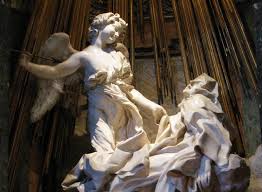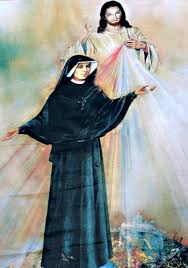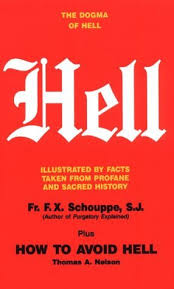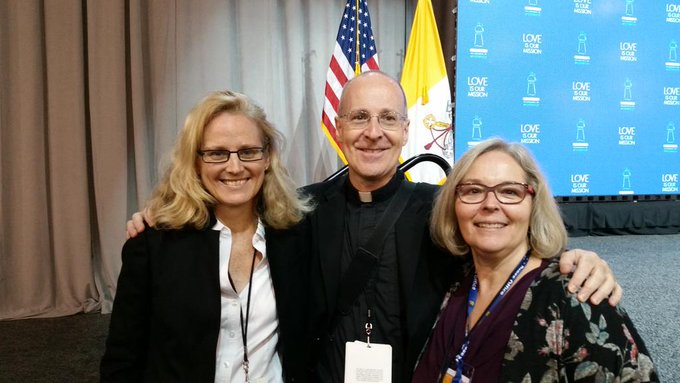OCTOBER 28, 2015
The Vatican has made a mistake and there is a cover up by liberal journalists
The Vatican has made a mistake and there is a cover up by liberal journalists. They themself made an objective error in the reporting of Vatican Council II. They are using a theology based on an objective error.It is promoted by the liberal universitiesincluding the pontifical ones.
The liberals journalists have all these years assumed that the baptism of desire and being saved in invincible ignorance referred to explicit cases and so they became exceptions to the strict interpretation of the dogma extra ecclesiam nulla salus. So Vatican Council II (LG 16 etc) became a break with the past, it became a break with the dogma for them.LG 16 would refer to explicit exceptions to all needing to formally enter the Church.
Now we know that these cases are not explicit for us and are known only to God also they would be followed by the baptism of water, which is the dogmatic teaching. So Vatican Council II does not contradict the Feeneyite version of the dogma.
Also the Holy Office 1949 made an objective mistake in the Fr. Leonard Feeney case. This is not being reported. There are no objective exceptions to the priest from Bostons' traditional interpretation of the dogma on exclusive salvation in the Catholic Church.
Also the Baltimore Catechism made a factual mistake when they placed the baptism of desire and baptism of blood along with the baptism of water and its necessity.The baptism of desire and blood, allegedly without the baptism of water, are not objective, visible and repeatable like the baptism of water. They do not exist in our reality. So they cannot be exceptions to all needing the baptism of water.The 1808 Catechism made a mistake and has influenced the reporting of AP and Reuters, on Vatican Council II and the Letter of the Holy Office to the Archbishop of Boston in 1949.
So it means that the Church's teaching on the Jews has not changed, since there are no exceptions mentioned in Vatican Council II to the dogma on salvation. So this contradicts the reports of Nicole Winfield and Phillip Pullela. They claim that the Church's teachings having been changed on the Jews ,with Vatican Council II.
Also the Holy Office 1949 made an objective mistake in the Fr. Leonard Feeney case. This is not being reported. There are no objective exceptions to the priest from Bostons' traditional interpretation of the dogma on exclusive salvation in the Catholic Church.
Also the Baltimore Catechism made a factual mistake when they placed the baptism of desire and baptism of blood along with the baptism of water and its necessity.The baptism of desire and blood, allegedly without the baptism of water, are not objective, visible and repeatable like the baptism of water. They do not exist in our reality. So they cannot be exceptions to all needing the baptism of water.The 1808 Catechism made a mistake and has influenced the reporting of AP and Reuters, on Vatican Council II and the Letter of the Holy Office to the Archbishop of Boston in 1949.
So it means that the Church's teaching on the Jews has not changed, since there are no exceptions mentioned in Vatican Council II to the dogma on salvation. So this contradicts the reports of Nicole Winfield and Phillip Pullela. They claim that the Church's teachings having been changed on the Jews ,with Vatican Council II.
Instead the Council says all need faith and baptism for salvation (AG 7) and Jews do not have either of the two. Also most people die without faith and baptism, indicating that most people are oriented to the fires of Hell 2 according to Vatican Council II (AG 7, LG 14).
The religion journalists do not want to report on this and are covering up an error made by the Vatican ( B is an exception to A) which is supported by them for political reasons.
-Lionel Andrades2
A young Korean artist taken to Hell. Drew pictures of it.
 ____________________
The entrance it seems to me was similar to a very long and narrow alleyway, like an oven, low and dark and confined; the floor seemed to me to consist of dirty, muddy water emitting foul stench and swarming with putrid vermin...The bodily pains were so unbearable that though I had suffered excruciating ones in this life and according to what doctors say, the worst that can be suffered on earth for all my nerves were shrunken when I was paralyzed, plus many other sufferings of many kinds that I endured and even some as I said, caused by the devil, these were all nothing in comparison with the ones I experienced there...-St.Teresa of Avila's description of Hell.
http://catholicharboroffaithandmorals.com/St.%20Teresa%20of%20Avila%20combat%20with%20Satan.html
____________________
The entrance it seems to me was similar to a very long and narrow alleyway, like an oven, low and dark and confined; the floor seemed to me to consist of dirty, muddy water emitting foul stench and swarming with putrid vermin...The bodily pains were so unbearable that though I had suffered excruciating ones in this life and according to what doctors say, the worst that can be suffered on earth for all my nerves were shrunken when I was paralyzed, plus many other sufferings of many kinds that I endured and even some as I said, caused by the devil, these were all nothing in comparison with the ones I experienced there...-St.Teresa of Avila's description of Hell.
http://catholicharboroffaithandmorals.com/St.%20Teresa%20of%20Avila%20combat%20with%20Satan.html
 ________________________________________________
These are the Tortures suffered by all thedamned together, but that is not the end of the sufferings.https://youtu.e/_La-_wEJ4Fk
There are special Tortures destined for particular souls. These are the torments of the senses. Each soul undergoes terrible and indescribable sufferings related to the manner in which it has sinned.
I would have diedThere are caverns and pits of torture where one form of agony differs from another. I would have died at the very sight of these tortures if the omnipotence of God had not supported me...-St.Faustina Kowalska's description of Hell.
___________________________________________
________________________________________________
These are the Tortures suffered by all thedamned together, but that is not the end of the sufferings.https://youtu.e/_La-_wEJ4Fk
There are special Tortures destined for particular souls. These are the torments of the senses. Each soul undergoes terrible and indescribable sufferings related to the manner in which it has sinned.
I would have diedThere are caverns and pits of torture where one form of agony differs from another. I would have died at the very sight of these tortures if the omnipotence of God had not supported me...-St.Faustina Kowalska's description of Hell.
___________________________________________
"Then I was pushed into one of those fiery cavities and pressed, as it were, between burning planks, and sharp nails and red-hot irons seemed to be piercing my flesh."
Here Josefa repeated the multiple tortures from which no single member of the body is excluded:
"I felt as if they were endeavoring to pull out my tongue, but could not. This torture reduced me to such agony that my very eyes seemed to be starting out of their sockets. I think this was because of the fire which burns, burns... not a finger-nail escapes terrifying torments, and all the time one cannot move even a finger to gain some relief, nor change posture, for the body seems flattened out and yet doubled in two.-Sr.Joseph Menendez's description of Hell.
_____________________________________________
There was a certain rich man, who was clothed in purple and fine linen; and feasted sumptuously every day. And there was a certain beggar, named Lazarus, who lay at his gate, full of sores,
Desiring to be filled with the crumbs that fell from the rich man' s table, and no one did give him; moreover the dogs came, and licked his sores. And it came to pass, that the beggar died, and was carried by the angels into Abraham' s bosom. And the rich man also died: and he was buried in hell. And lifting up his eyes when he was in torments, he saw Abraham afar off, and Lazarus in his bosom: And he cried, and said: Father Abraham, have mercy on me, and send Lazarus, that he may dip the tip of his finger in water, to cool my tongue: for I am tormented in this flame. And Abraham said to him: Son, remember that thou didst receive good things in thy lifetime, and likewise Lazareth evil things, but now he is comforted; and thou art tormented.
And besides all this, between us and you, there is fixed a great chaos: so that they who would pass from hence to you, cannot, nor from thence come hither. And he said: Then, father, I beseech thee, that thou wouldst send him to my father' s house, for I have five brethren, That he may testify unto them, lest they also come into this place of torments. And Abraham said to him: They have Moses and the prophets; let them hear them. But he said: No, father Abraham: but if one went to them from the dead, they will do penance.
And he said to him: If they hear not Moses and the prophets, neither will they believe, if one rise again from the dead. -Luke :19-31, The Rich Man (Dives) and Lazarus.
Second Circle (Lust)
In the second circle of Hell are those overcome bylust. Dante condemns these "carnal malefactors"[ for letting their appetites sway their reason. They are the first ones to be truly punished in Hell. These souls are blown back and forth by the terrible winds of a violent storm, without rest. This symbolizes the power of lust to blow one about needlessly and aimlessly.
In this circle, Dante seesSemiramis,Dido,Cleopatra,Helen of Troy,Achilles,Paris,Tristan, and many others who were overcome by sexual love during their life. Dante is told byFrancesca da Riminihow she and her husband's brotherPaolo Malatestacommitted adultery, but then died a violent death, in the name of Love, at the hands of her husband,Giovanni (Gianciotto). Francesca reports that their act of adultery was triggered by reading the adulterous story ofLancelotandGuinevere(an episode sculpted byAuguste RodininThe Kiss). Nevertheless, she predicts that her husband will be punished for hisfratricidein Caïna, within the ninth circle (Canto V).
Alse see Dante's experience in Hell in The Divine Comedy( Inferno).
_______________________________________
http://eucharistandmission.blogspot.it/2015/04/didnt-jesus-teach-about-hell.html
____________________
The entrance it seems to me was similar to a very long and narrow alleyway, like an oven, low and dark and confined; the floor seemed to me to consist of dirty, muddy water emitting foul stench and swarming with putrid vermin...The bodily pains were so unbearable that though I had suffered excruciating ones in this life and according to what doctors say, the worst that can be suffered on earth for all my nerves were shrunken when I was paralyzed, plus many other sufferings of many kinds that I endured and even some as I said, caused by the devil, these were all nothing in comparison with the ones I experienced there...-St.Teresa of Avila's description of Hell.
http://catholicharboroffaithandmorals.com/St.%20Teresa%20of%20Avila%20combat%20with%20Satan.html
"Then I was pushed into one of those fiery cavities and pressed, as it were, between burning planks, and sharp nails and red-hot irons seemed to be piercing my flesh."
Here Josefa repeated the multiple tortures from which no single member of the body is excluded:
"I felt as if they were endeavoring to pull out my tongue, but could not. This torture reduced me to such agony that my very eyes seemed to be starting out of their sockets. I think this was because of the fire which burns, burns... not a finger-nail escapes terrifying torments, and all the time one cannot move even a finger to gain some relief, nor change posture, for the body seems flattened out and yet doubled in two.-Sr.Joseph Menendez's description of Hell.
_____________________________________________
Desiring to be filled with the crumbs that fell from the rich man' s table, and no one did give him; moreover the dogs came, and licked his sores. And it came to pass, that the beggar died, and was carried by the angels into Abraham' s bosom. And the rich man also died: and he was buried in hell. And lifting up his eyes when he was in torments, he saw Abraham afar off, and Lazarus in his bosom: And he cried, and said: Father Abraham, have mercy on me, and send Lazarus, that he may dip the tip of his finger in water, to cool my tongue: for I am tormented in this flame. And Abraham said to him: Son, remember that thou didst receive good things in thy lifetime, and likewise Lazareth evil things, but now he is comforted; and thou art tormented.
And besides all this, between us and you, there is fixed a great chaos: so that they who would pass from hence to you, cannot, nor from thence come hither. And he said: Then, father, I beseech thee, that thou wouldst send him to my father' s house, for I have five brethren, That he may testify unto them, lest they also come into this place of torments. And Abraham said to him: They have Moses and the prophets; let them hear them. But he said: No, father Abraham: but if one went to them from the dead, they will do penance.
And he said to him: If they hear not Moses and the prophets, neither will they believe, if one rise again from the dead. -Luke :19-31, The Rich Man (Dives) and Lazarus.
Second Circle (Lust)
In the second circle of Hell are those overcome bylust. Dante condemns these "carnal malefactors"[ for letting their appetites sway their reason. They are the first ones to be truly punished in Hell. These souls are blown back and forth by the terrible winds of a violent storm, without rest. This symbolizes the power of lust to blow one about needlessly and aimlessly.
In this circle, Dante seesSemiramis,Dido,Cleopatra,Helen of Troy,Achilles,Paris,Tristan, and many others who were overcome by sexual love during their life. Dante is told byFrancesca da Riminihow she and her husband's brotherPaolo Malatestacommitted adultery, but then died a violent death, in the name of Love, at the hands of her husband,Giovanni (Gianciotto). Francesca reports that their act of adultery was triggered by reading the adulterous story ofLancelotandGuinevere(an episode sculpted byAuguste RodininThe Kiss). Nevertheless, she predicts that her husband will be punished for hisfratricidein Caïna, within the ninth circle (Canto V).
In this circle, Dante seesSemiramis,Dido,Cleopatra,Helen of Troy,Achilles,Paris,Tristan, and many others who were overcome by sexual love during their life. Dante is told byFrancesca da Riminihow she and her husband's brotherPaolo Malatestacommitted adultery, but then died a violent death, in the name of Love, at the hands of her husband,Giovanni (Gianciotto). Francesca reports that their act of adultery was triggered by reading the adulterous story ofLancelotandGuinevere(an episode sculpted byAuguste RodininThe Kiss). Nevertheless, she predicts that her husband will be punished for hisfratricidein Caïna, within the ninth circle (Canto V).
Alse see Dante's experience in Hell in The Divine Comedy( Inferno).
_______________________________________
http://eucharistandmission.blogspot.it/2015/04/didnt-jesus-teach-about-hell.html
_______________________________________
http://eucharistandmission.blogspot.it/2015/04/didnt-jesus-teach-about-hell.html
FIFTH EXERCISE
IT IS A MEDITATION ON HELL
It contains in it, after the Preparatory Prayer and two Preludes, five Points and one Colloquy:
Prayer. Let the Preparatory Prayer be the usual one.
First Prelude. The first Prelude is the composition, which is here to see with the sight of the imagination the length, breadth and depth of Hell.
Second Prelude. The second, to ask for what I want: it will be here to ask for interior sense of the pain which the damned suffer, in order that, if, through my faults, I should forget the love of the Eternal Lord, at least the fear of the pains may help me not to come into sin.
First Point. The first Point will be to see with the sight of the imagination the great fires, and the souls as in bodies of fire.
Second Point. The second, to hear with the ears wailings, howlings, cries, blasphemies against Christ our Lord and against all His Saints.
Third Point. The third, to smell with the smell smoke, sulphur, dregs and putrid things.
Fourth Point. The fourth, to taste with the taste bitter things, like tears, sadness and the worm of conscience.
Fifth Point. The fifth, to touch with the touch; that is to say, how the fires touch and burn the souls.
 Colloquy. Making a Colloquy to Christ our Lord, I will bring to memory the souls that are in Hell, some because they did not believe the Coming, others because, believing, they did not act according to His Commandments; making three divisions...
- The Spiritual Exercises of St. Ignatius of Loyola, [1914]http://www.sacred-texts.com/chr/seil/seil15.htm
People that died and saw hell. Video Testimonies of Hell
Colloquy. Making a Colloquy to Christ our Lord, I will bring to memory the souls that are in Hell, some because they did not believe the Coming, others because, believing, they did not act according to His Commandments; making three divisions...
- The Spiritual Exercises of St. Ignatius of Loyola, [1914]http://www.sacred-texts.com/chr/seil/seil15.htm
People that died and saw hell. Video Testimonies of Hell
Atheist College Professor dies and sees hell and demons - it changed his life

By A Customer on Nov. 5 1999
Hell and How to Avoid Hell by Thomas A. Nelson
(Amazon Books)
This book is an absolute must for everyone, regardless if you are Christian or not! You will not be able to put the book down as it captivates you with an absolutely overwhelming feeling of fear and terror. It really causes you to re-evaluate your own conscience and whether or not you are on the path to heaven. This book is especially needed for those who do not know Jesus Christ and for those that do know Him but think they are "once saved always saved." The Bible clearly states that we must accept Christ into our lives in order to be saved from the fires of Hell, but we must also "work out our salvation with nervous trembling." This book discusses these points in great detail as well as many other important biblical facts about Heaven, Hell, and salvation. It's a must buy!
Prayer. Let the Preparatory Prayer be the usual one.
First Prelude. The first Prelude is the composition, which is here to see with the sight of the imagination the length, breadth and depth of Hell.
Second Prelude. The second, to ask for what I want: it will be here to ask for interior sense of the pain which the damned suffer, in order that, if, through my faults, I should forget the love of the Eternal Lord, at least the fear of the pains may help me not to come into sin.
First Point. The first Point will be to see with the sight of the imagination the great fires, and the souls as in bodies of fire.
Second Point. The second, to hear with the ears wailings, howlings, cries, blasphemies against Christ our Lord and against all His Saints.
Third Point. The third, to smell with the smell smoke, sulphur, dregs and putrid things.
Fourth Point. The fourth, to taste with the taste bitter things, like tears, sadness and the worm of conscience.
Fifth Point. The fifth, to touch with the touch; that is to say, how the fires touch and burn the souls.
 Colloquy. Making a Colloquy to Christ our Lord, I will bring to memory the souls that are in Hell, some because they did not believe the Coming, others because, believing, they did not act according to His Commandments; making three divisions...
Colloquy. Making a Colloquy to Christ our Lord, I will bring to memory the souls that are in Hell, some because they did not believe the Coming, others because, believing, they did not act according to His Commandments; making three divisions...
- The Spiritual Exercises of St. Ignatius of Loyola, [1914]http://www.sacred-texts.com/chr/seil/seil15.htm
People that died and saw hell. Video Testimonies of Hell
Atheist College Professor dies and sees hell and demons - it changed his life
By A Customer on Nov. 5 1999
Hell and How to Avoid Hell by Thomas A. Nelson
(Amazon Books)
(Amazon Books)
This book is an absolute must for everyone, regardless if you are Christian or not! You will not be able to put the book down as it captivates you with an absolutely overwhelming feeling of fear and terror. It really causes you to re-evaluate your own conscience and whether or not you are on the path to heaven. This book is especially needed for those who do not know Jesus Christ and for those that do know Him but think they are "once saved always saved." The Bible clearly states that we must accept Christ into our lives in order to be saved from the fires of Hell, but we must also "work out our salvation with nervous trembling." This book discusses these points in great detail as well as many other important biblical facts about Heaven, Hell, and salvation. It's a must buy!
Went To Hell For Suicide
Atheist College Professor dies and sees hell and demons - it changed his life
Atheist College Professor dies and sees hell and demons - it changed his life
___________________________________
http://eucharistandmission.blogspot.it/2015/10/the-vatican-has-made-mistake-and-there.html
___________________________________
http://eucharistandmission.blogspot.it/2015/10/the-vatican-has-made-mistake-and-there.html


.jpg)






